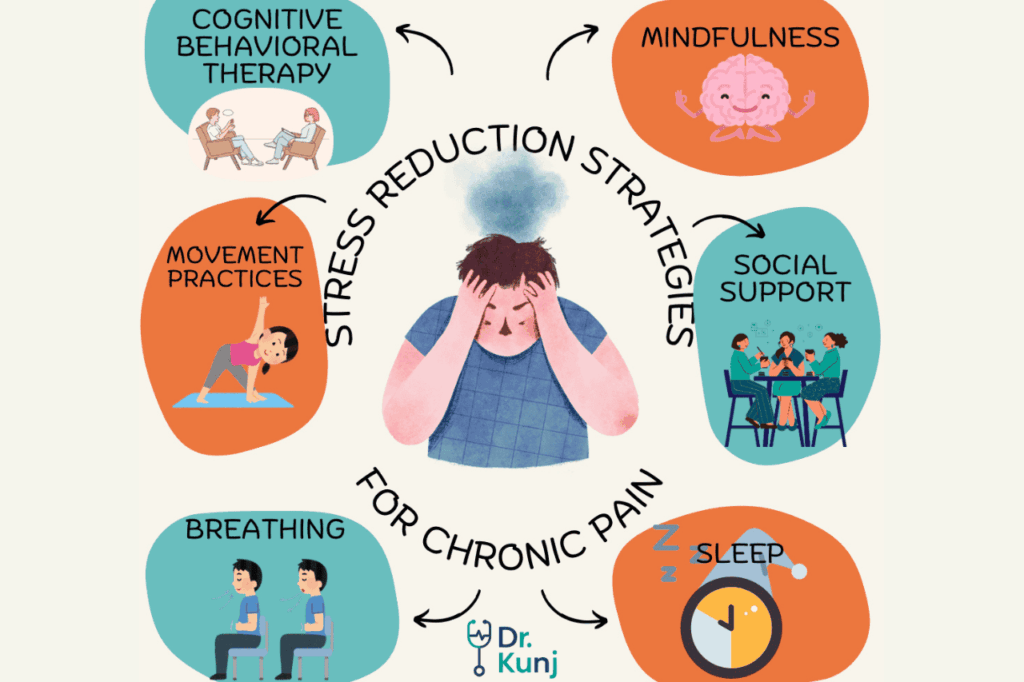Living with chronic pain can feel like an endless battle, and stress only adds fuel to the fire. Science shows that stress doesn’t just affect your mood—it can directly amplify your pain through powerful chemical processes in your body. The good news? You have more control than you may realize. Let’s explore how stress and chronic pain are connected, and practical ways to break the cycle.
What is Chronic Pain?
Chronic pain is defined as pain lasting more than three months. Unlike acute pain, which signals injury or danger, chronic pain often lingers long after the original cause has healed. This type of pain is complex because it involves not just the body, but also how your spinal cord and brain process signals.
Neurotransmitters and stress hormones—such as cortisol, norepinephrine, and epinephrine—play a central role in how pain is experienced. Stress alters these chemicals, creating a feedback loop where the brain and nervous system amplify one another, intensifying pain.
Stress and the Pain Feedback Loop
The Science Behind the Connection
Stress hormones heighten the sensitivity of your nervous system. When stress is constant, this loop keeps firing, making pain feel sharper and more persistent. Essentially, stress can “train” your brain and nerves to remain in a heightened state of alert, locking you in a cycle of stress and chronic pain.
Measuring Stress: HRV as a Clue
One objective way to assess stress is by measuring Heart Rate Variability (HRV)—the variation in timing between consecutive heartbeats. It provides insight into how well your autonomic (electrical) control systems are balancing sympathetic (stress) and parasympathetic (rest) responses.
- Low HRV (around 30ms or less): Linked to high stress.
- High HRV (70ms or more): A sign of relaxation and resilience.
Monitoring HRV can help you understand how stress may be impacting your pain day to day.
Proven Stress-Reduction Strategies for Chronic Pain
The good news is that lifestyle interventions can interrupt this cycle. Here are evidence-backed techniques that help reduce both stress and chronic pain.
Mindfulness-Based Stress Reduction (MBSR)
MBSR is a form of meditation that teaches you to focus on the present moment, for example concentrate in relaxing your muscles. In studies, people who practiced mindfulness for 45 minutes a day, six days a week reduced their reliance on opioid medications and reported significant pain relief.
Even if you can’t dedicate that much time, shorter daily sessions can still bring noticeable improvements.
Cognitive Behavioral Therapy (CBT)
CBT helps reframe negative thoughts that worsen pain and stress. In research, participants practicing CBT just one hour per week reported meaningful pain reduction, though the results were less dramatic compared to mindfulness. Still, CBT is a powerful tool for shifting your mindset and coping with stress.
Movement Practices: Yoga, Tai Chi, and Exercise
- Yoga: Practiced 2–3 times per week, yoga combines movement, breath, and relaxation, all of which reduce stress hormones.
- Tai Chi: Surprisingly, studies show Tai Chi can be even more effective than aerobic exercise for lowering stress and easing pain.
- Aerobic Exercise: While not as effective for stress as Tai Chi, it still plays a key role in overall health. The standard recommendation is 150 minutes per week of moderate-intensity activity, which helps regulate cortisol and supports cardiovascular health.
Breathing and Guided Imagery
Deep breathing isn’t just calming—it can actively lower pain intensity. Try diaphragmatic, also called abdominal or belly breathing:
- Sit comfortably with support in your back.
- Breathe in through nose for 4 to 6 seconds, focusing on your belly rising.
- Exhale through your mouth for 4 to 6 seconds, letting your belly fall inward.
This simple practice can reduce your average pain rating by a full point. Adding guided imagery—visualizing calming scenes—enhances the effect.
Sleep: The Ultimate Stress Reset
Poor sleep increases stress hormones and worsens chronic pain. Aim for 7–9 hours of sleep in a cool, dark room. Consistent bedtime routines, limiting screen time before bed, and using relaxation practices can significantly improve both rest and pain levels.
Social Support and Connection
Perhaps the most underestimated pain reliever is human connection. Studies reveal that strong social support can reduce pain scores by almost half a point.
Practical ways to build this habit:
- Schedule weekly family or friend time.
- Make a five-minute daily call to a loved one.
- Engage in brief social interactions—at the park, the store, or even a casual chat with a neighbor.
Even short moments of genuine connection can provide hours of stress relief.
Journaling and Gratitude
Ending the day with a simple gratitude journal helps shift focus from pain to positivity. Writing down three things you’re grateful for every evening boosts mood, lowers stress, and supports resilience against chronic pain.
Pulling It All Together
Stress and chronic pain are deeply intertwined, but you are not powerless. By targeting stress through:
- Mindfulness and CBT to retrain the brain.
- Movement and breathwork to calm the body.
- Sleep, social connection, and gratitude to restore balance.
You can weaken the feedback loop between stress and pain. Even small daily changes—like five minutes of breathing or a short phone call—add up to meaningful improvements over time.
Final Thoughts
The relationship between stress and chronic pain is complicated, but also empowering once you understand it. Stress hormones may intensify pain, but lifestyle practices can interrupt the cycle and restore quality of life.
If you live with chronic pain, start small. Pick one or two of the strategies above, and gradually build them into your routine. Over time, you’ll notice not just less stress, but less pain—and a more energized, balanced life. Watch the video for the tips by Dr. Kunj.
Disclaimer: This blog is for educational purposes only and is not medical advice. Always consult a qualified healthcare provider before making changes to your treatment plan.



